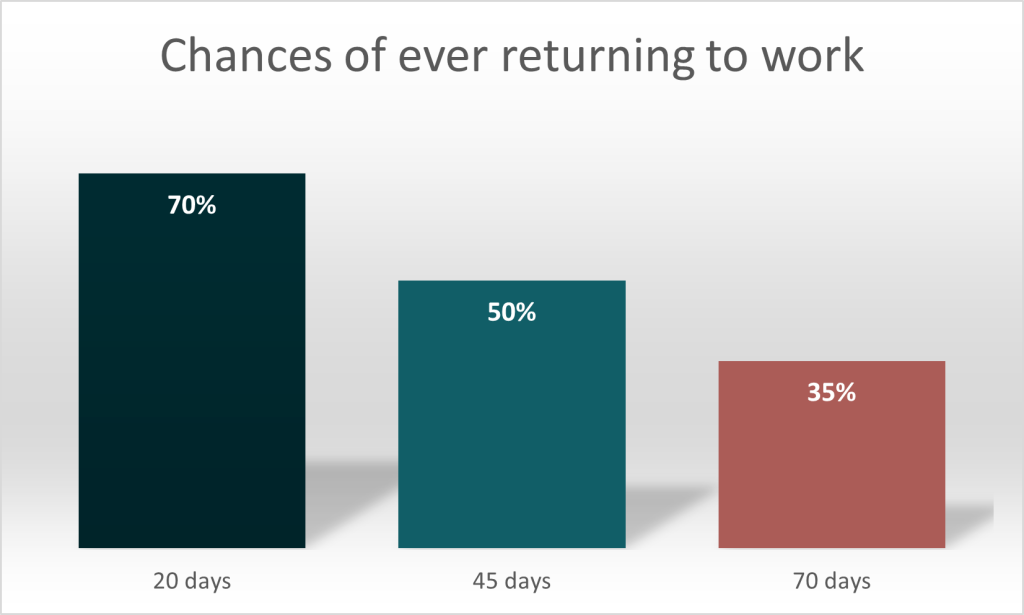Seven compelling health benefits of getting your patients back to work

As a GP, you are in a unique position of being able to improve the health of your patients who have been injured by encouraging them to return to work as soon as they are able.
The evidence is irrefutable that the health benefits of work far outweigh any risks, and by supporting your patients to return to work after injury, you’ll be having a very positive impact on their overall physical and mental wellbeing. After all, “the good physician treats the disease; the great physician treats the patient who has the disease”.[1]
However, when faced with 54-year-old Mr Jones, who is adamant that he needs to rest at home until fully recovered, finding the right arguments to promote his earlier return to work can be challenging. That’s why we’ve put together a list of seven compelling, evidence-based health benefits of returning to work after injury to help you. No more umming and ahing – just consult the list!
Health benefit 1: Reduces financial stress
“No work, no pay”, as grandma used to say. However, even with modern compensation schemes, injured workers are usually forced to get by on a reduced income. Is Mr Jones aware that his reduced income is likely to negatively affect his health by limiting access to adequate and safe shelter, proper nutrition, utilities and various other elements that shape a person’s standard of living. Indeed, these social determinants have such a great impact on health that poorer Australians live up to 6.4 fewer years than the wealthiest Australians[2].
Health benefit 2: Speeds up recovery
Contrary to what Mr Jones might believe, waiting for full recovery before returning to work in most cases actually delays the recovery process. There is broad consensus among healthcare researchers and practitioners that those who are supported to return to work while still recovering tend to recover more speedily than those who do not. Workplace interventions, such as working fewer hours or lifting less, have even been shown to be effective in improving pain and functional status among those with musculoskeletal disorders. “So, Mr Jones, along with those anti-inflammatories, I’m prescribing a course of work as part of your treatment plan.”
Health benefit 3: Supports better physical health
Working individuals are physically healthier individuals. How do we know this? Worklessness has been associated with various negative health effects, including this most startling statistic: the risk of death is up to 60% higher among people who are unemployed! Specifically, people experiencing worklessness show an increased mortality from cardiovascular disease and suicide. They also have increased rates of lung cancer and susceptibility to respiratory infections.
As a result of this poorer overall general health, worklessness also leads to higher rates of medical consultations, medication consumption and hospital admissions – “and we don’t want that now, do we Mr Jones!”.
Embrace the opportunity to return to work, for in the rhythm of effort lies the melody of achievement and the harmony of purpose.
Anon.
Health benefit 4: Encourages more physical activity
Returning to work encourages more physical activity which, as we all know, contributes to better health. Even those in the most sedentary of jobs tend to move more on work days, walking to and from public transport, between meetings or even just from their desk to the kitchen, than they would do if at home.
Health benefit 5: Improves mental and psychological wellbeing
Return to work after injury improves mental and psychological wellbeing. That’s because work plays an important role in maintaining our self-esteem by making us feel like valued and productive members of society. It gives structure to our days and weeks (important for good mental health) and interacting with colleagues and work friends fosters a sense of community and social inclusion. Work has even been shown to improve sleep!
Health benefit 6: Decreases the likelihood of engaging in risky behaviours
Being employed decreases the likelihood of engaging in risky behaviours, such as drinking excessive alcohol or taking illicit drugs. Research has shown that unemployed individuals are 1.6 times as likely to use cannabis, 2.4 times as likely to use meth/amphetamines and 1.8 times as likely to use ecstasy as employed people.
Health benefit 7: Reaps benefits for the whole family
Mr Jones still not convinced that returning to work is in his best interests? Then, if relevant, it’s time to play the family card: Children with parents without employment have a higher likelihood of having chronic diseases, increased experience of psychological distress and increased likelihood of being out of work themselves (either for periods of time or over their entire life).
Finally, it’s important to communicate to Mr Jones that the longer he stays away from work after injury, the less likely he is to ever return to work, as shown in the graph below. An injured worker’s belief that symptoms are a sign of harm or damage can sustain a cycle of fear and avoidance of activities of daily living, including work-related activities.

There is no doubt that the sooner Mr Jones can return to work after injury, the better, and the sooner he can begin to reap the many physical, mental and financial benefits that work brings.
A key objective of the National Return to Work Strategy is to see an increase in positive return to work experiences for workers with a work-related injury or illness. You, as a GP, play a crucial role in supporting your patients to return to work safely and sustainably, with your first task being to ensure that they understand the health benefits of getting back to work. If you can convince Mr Jones, you can convince anybody!
GPEx’s ReturnToWorkGP course has been designed in collaboration with ReturnToWorkSA to provide South Australian GPs, registrars, practice nurses and practice managers with the skills, tools and knowledge to help guide and progress their patients’ recovery and return to work. This includes navigating the Return to Work Scheme, completing the Work Capacity Certificate and understanding the support services available to enable their patients to successfully transition back into work, sooner.
[1] Sir William Osler
[2] Australia’s Health Tracker by Socioeconomic Status (2021), Australian Health Policy Collaboration & Mitchell Institute.